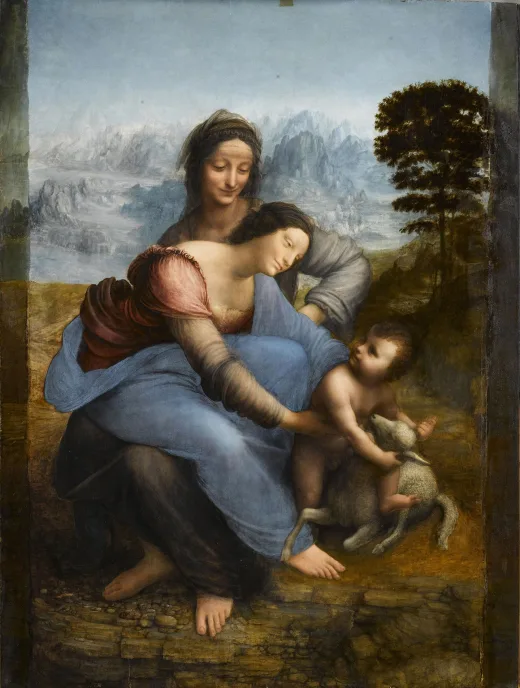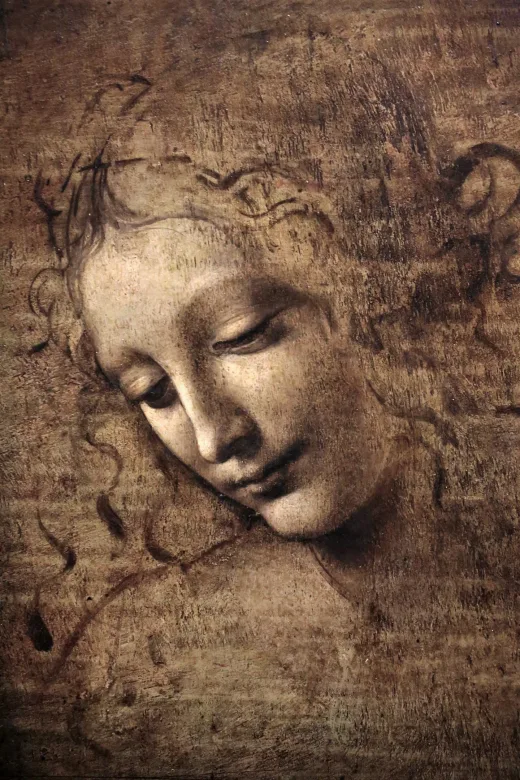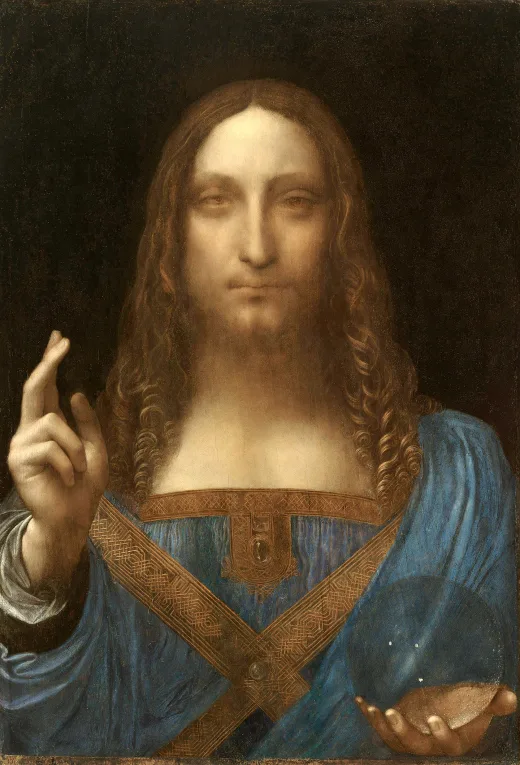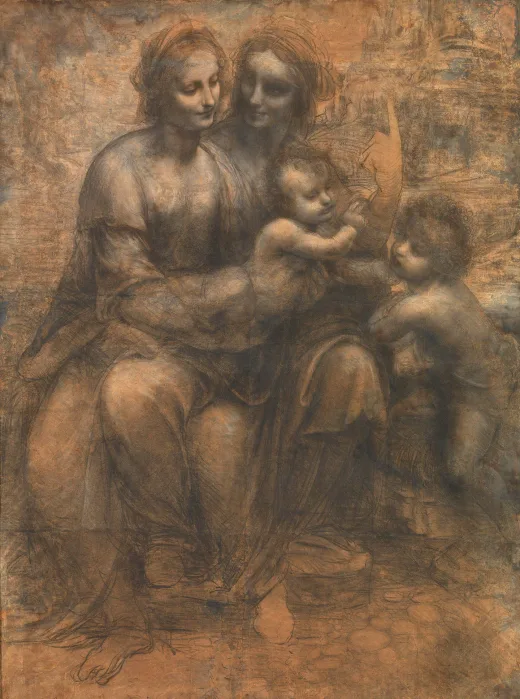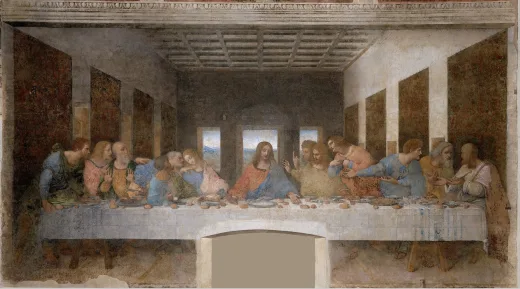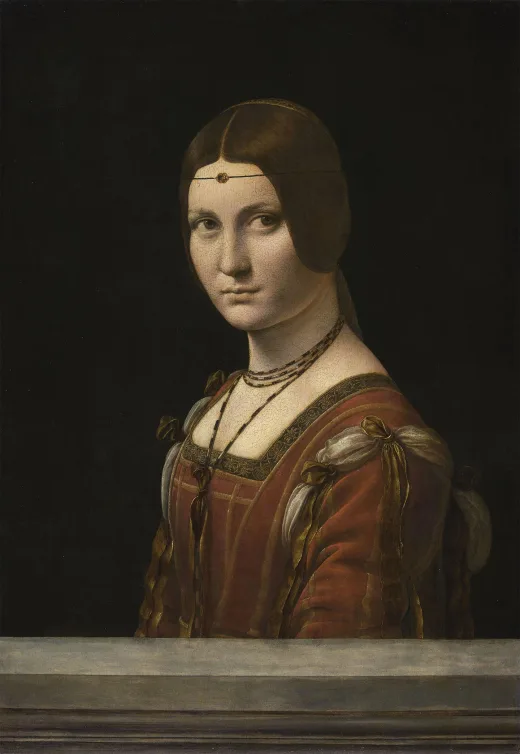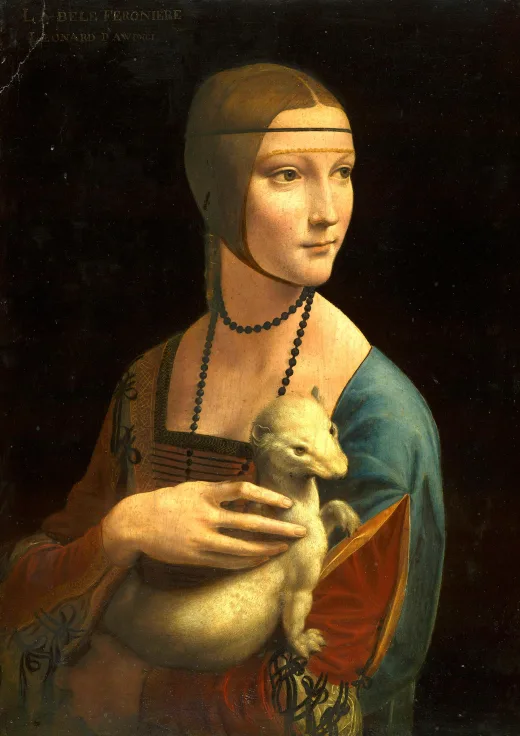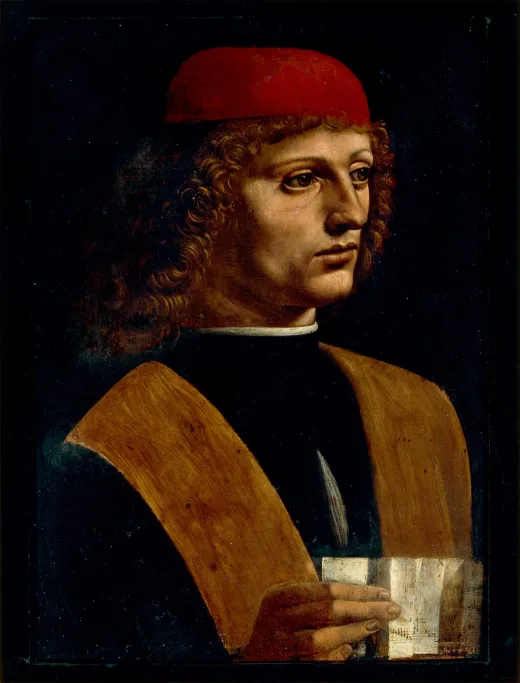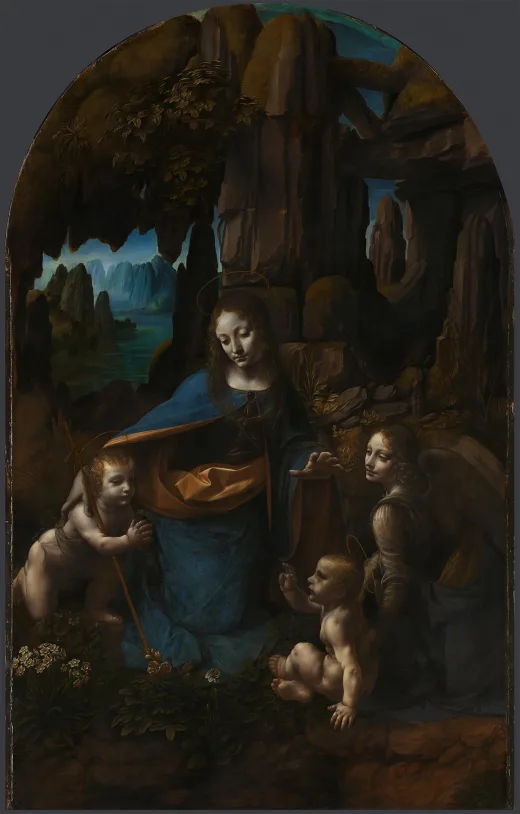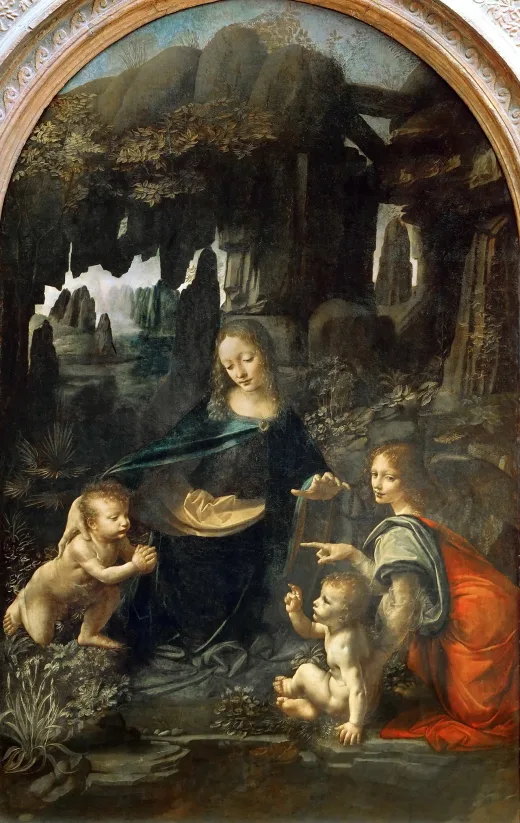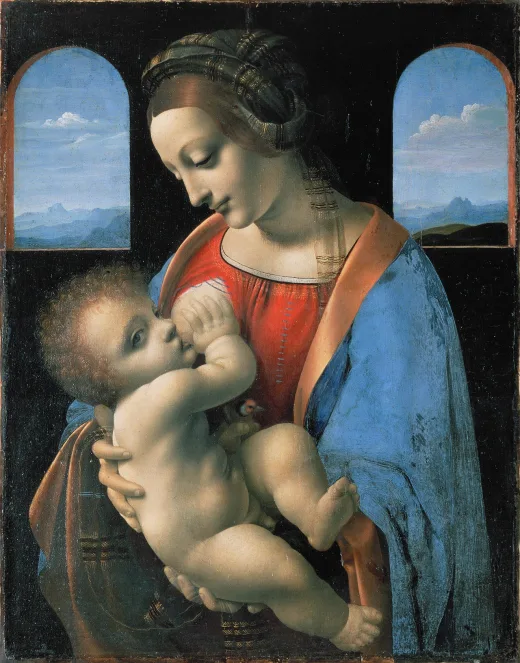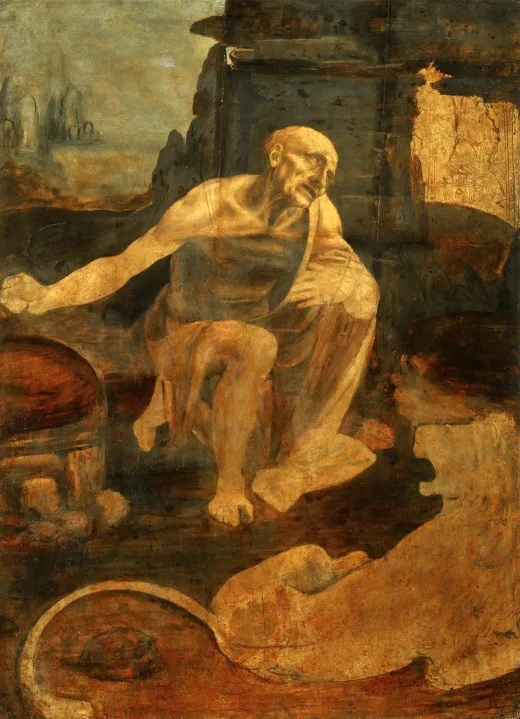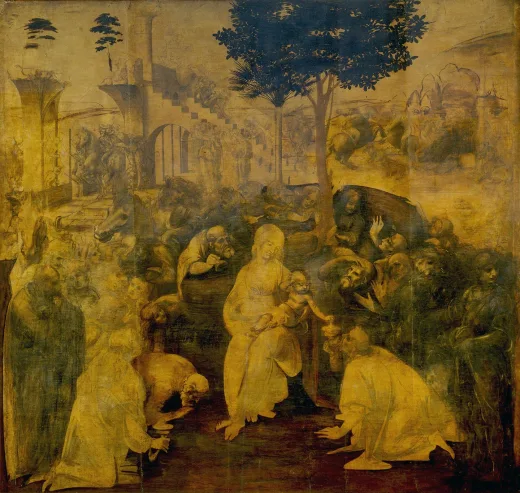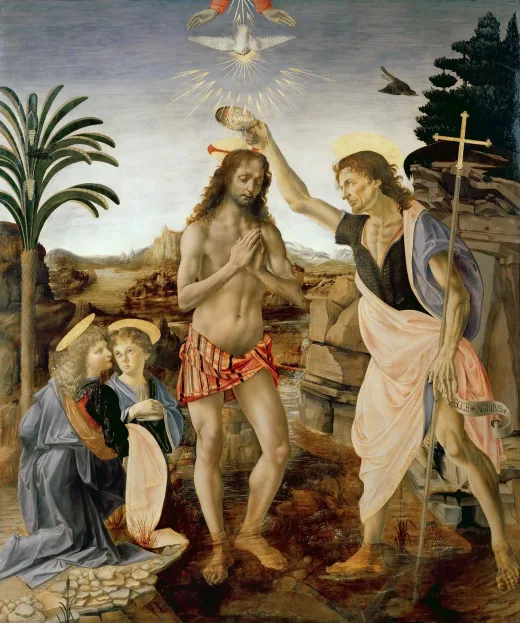达·芬奇《蒙娜丽莎》高清图片
原图尺寸:6260×9329像素(300 DPI)高清图
下载原图消耗4艺点
文件大小:137.64 MB
下载格式: ZIP ( PNG+JPG )
作品名称:蒙娜丽莎
Mona Lisa
作品作者:列奥纳多·达·芬奇(Leonardo da Vinci)
创作时间:约 1503–1506 年,可能持续到约 1517 年
作品风格:文艺复兴盛期
原作尺寸:77×53厘米
作品材质:杨木板油画
收藏位置:巴黎卢浮宫博物馆

作品简介
《蒙娜丽莎》是意大利艺术家列奥纳多·达·芬奇创作的半身肖像画。作为意大利文艺复兴时期的典范杰作,它被誉为"全球知名度最高、参观人数最多、被书写最频繁、被传唱最广泛、被戏仿最多次的艺术作品"。这幅画的创新特质包括:主人公神秘的微笑、恢弘的构图、细腻的形体塑造以及充满氛围感的透视技法。
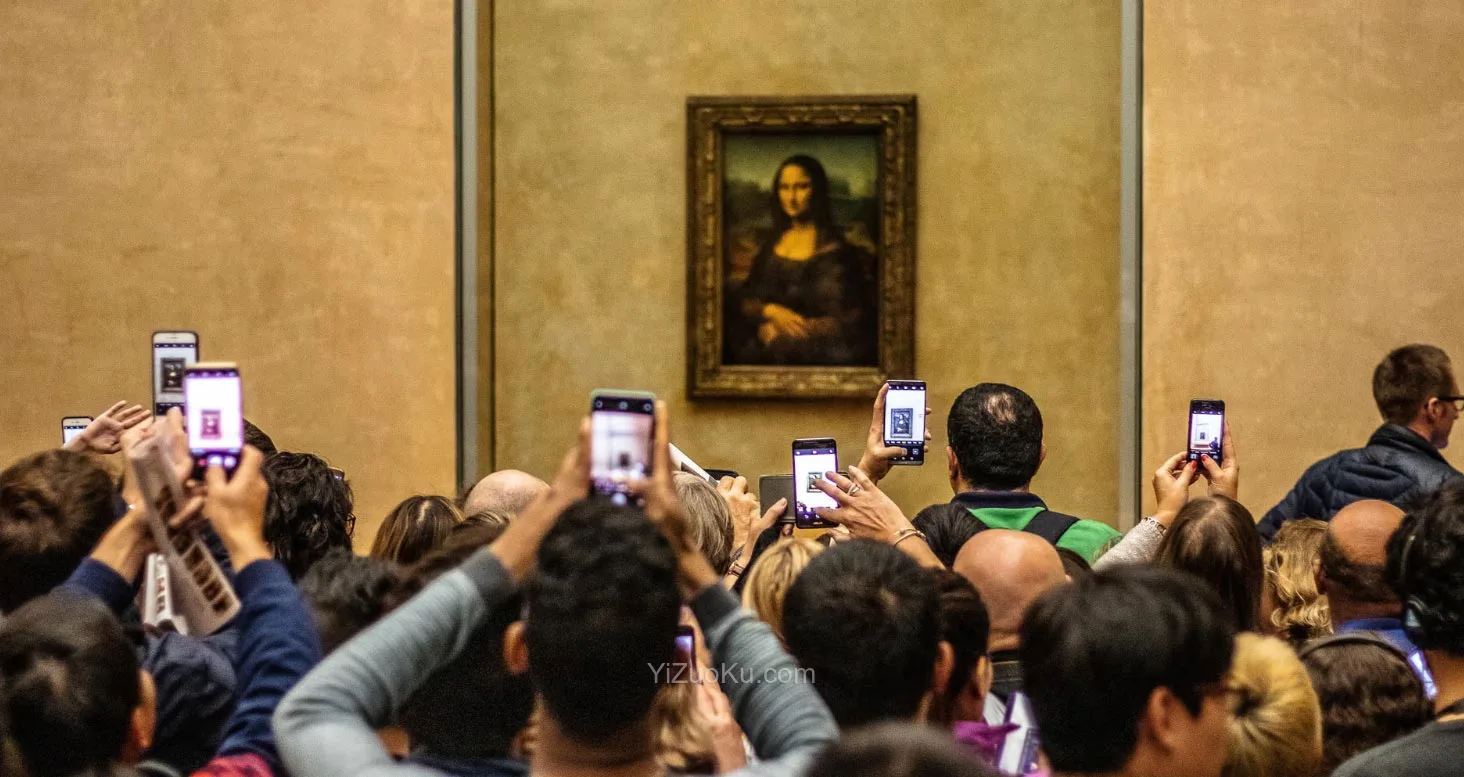
传统观点认为画中人物是意大利贵族女性丽莎·德尔·乔康多。作品绘制在白杨木板上,采用油画技法。达·芬奇从未将此画交付乔康多家族,据信创作于1503至1506年间,但艺术家可能持续修改至1517年。法国国王弗朗索瓦一世在1519年达·芬奇去世后获得此作,现为法兰西共和国财产,自1797年起长期陈列于巴黎卢浮宫。
该画的全球声誉部分源于1911年文森佐·佩鲁贾的盗窃事件,这位意大利爱国者声称画作应归属祖国。这起盗窃案及1914年的追回引发了空前的舆论轰动,催生出诸多文化衍生作品:包括1915年歌剧《蒙娜丽莎》、1930年代两部电影(《蒙娜丽莎失窃记》与《亚森·罗宾》),以及纳·京·科尔演唱的同名歌曲——后者成为1950年代最成功的流行金曲之一。
画作英文名"Mona Lisa"基于其描绘丽莎·德尔·乔康多的假设,但真实性存疑。文艺复兴艺术史家乔治·瓦萨里记载:"达·芬奇受弗朗切斯科·德尔·乔康多委托,为其夫人蒙娜丽莎绘制肖像"。意大利语"Monna"是"ma donna"(相当于英语"Madam")的尊称变体。值得注意的是,意大利语标准拼写为"Monna Lisa"(因"mona"在意大利语含粗俗之意),英语世界则惯用"Mona"拼写。
丽莎·德尔·乔康多出身佛罗伦萨吉拉尔迪尼家族,嫁予富有的丝绸商人弗朗切斯科。此画可能是为庆祝他们次子安德烈亚诞生而作的宅邸装饰画。意大利语画名"La Gioconda"意为"愉悦者",既呼应女主人的夫姓"Giocondo",又暗喻画中人的神态。法语名"La Joconde"同理。瓦萨里的记载源自其1550年出版的达·芬奇传记,虽成书于艺术家去世31年后,仍是关于画作来源最著名的史料。达·芬奇助手萨莱1524年去世时,遗产清单载有名为"la Gioconda"的肖像画,系大师遗赠。
2005年海德堡大学学者在一册1477年版西塞罗著作的边注中取得突破性发现。这条1503年10月的笔记由达·芬奇同代人阿戈斯蒂诺·韦斯普奇撰写,将正在创作丽莎·德尔·乔康多肖像的达·芬奇比作古希腊画家阿佩莱斯。卢浮宫代表文森特·德柳万对此回应:"我们现在可以确定1503年达·芬奇正在绘制丽莎·德尔·乔康多的肖像,但无法百分百确认就是卢浮宫藏本。"
2019年《达·芬奇作品全集》认定画中人为丽莎·德尔·乔康多的可能性最高,伊莎贝拉·德斯特是唯一合理的替代人选。学界另有多种理论:有人认为瓦萨里记载的《蒙娜丽莎》是另一幅失传作品;还有学者提出至少四位可能原型,包括阿拉贡的伊莎贝拉、切奇利娅·加莱拉尼等。精神分析学家弗洛伊德甚至认为,画中微笑源自达·芬奇对生母卡特里娜的记忆投射。
画作与文艺复兴时期圣母像高度相似,体现当时的女性理想形象。主人公在"pozzetto"扶手椅中保持挺拔坐姿,叠放的双手显露出拘谨仪态。其凝视观众的眼神与达·芬奇独创的"无轮廓线画法"赋予人物非凡的生命力。通过晕涂法营造的微妙表情"主要集中在嘴角和眼角",形成难以捉摸的情绪氛围。
这种四分之三侧身像构图,与15世纪末洛伦佐·迪·克雷迪等人的作品类似。艺术史家弗兰克·策尔纳指出人物整体姿态可追溯至佛兰德斯肖像传统,特别是画面两侧的立柱处理源自佛兰德斯先驱。背景中的虚构风景(亦有学者认为是真实地貌)开创意大利肖像画先河,达·芬奇运用空气透视法使远山小径渐隐于薄雾。最新地质学研究指出背景可能描绘科莫湖畔莱科的实景。
2007年法国工程师帕斯卡尔·科特的高清扫描显示:
原始绘有睫毛眉毛(可能因过度清洁脱落)
面部比例与视线方向经过多次修改
底层存在被覆盖的珍珠头饰发簪
哈佛大学教授玛格丽特·利文斯通2003年研究发现:直视时微笑消失,因中央视觉不擅捕捉阴影,而周边视觉能更好感知这一光学效应。2023年地质学家安·皮佐鲁索考证背景中的四拱桥应为阿雷佐附近的古罗马时期雷蒂纳桥,否定了此前其他桥梁的推测。
The Mona Lisa[a] is a half-length portrait painting by the Italian artist Leonardo da Vinci. Considered an archetypal masterpiece of the Italian Renaissance, it has been described as "the best known, the most visited, the most written about, the most sung about, [and] the most parodied work of art in the world." The painting's novel qualities include the subject's enigmatic expression, monumentality of the composition, the subtle modelling of forms, and the atmospheric illusionism.
The painting has been traditionally considered to depict the Italian noblewoman Lisa del Giocondo. It is painted in oil on a white poplar panel. Leonardo never gave the painting to the Giocondo family. It was believed to have been painted between 1503 and 1506; however, Leonardo may have continued working on it as late as 1517. King Francis I of France acquired the Mona Lisa after Leonardo's death in 1519, and it is now the property of the French Republic. It has normally been on display at the Louvre in Paris since 1797.
The painting's global fame and popularity partly stem from its 1911 theft by Vincenzo Peruggia, who attributed his actions to Italian patriotism—a belief it should belong to Italy. The theft and subsequent recovery in 1914 generated unprecedented publicity for an art theft, and led to the publication of many cultural depictions such as the 1915 opera Mona Lisa, two early 1930s films (The Theft of the Mona Lisa and Arsène Lupin), and the song "Mona Lisa" recorded by Nat King Cole—one of the most successful songs of the 1950s.
The title of the painting, which is known in English as Mona Lisa, is based on the presumption that it depicts Lisa del Giocondo, although her likeness is uncertain. Renaissance art historian Giorgio Vasari wrote that "Leonardo undertook to paint, for Francesco del Giocondo, the portrait of Mona Lisa, his wife." Monna in Italian is a polite form of address originating as ma donna—similar to Ma'am, Madam, or my lady in English. This became madonna, and its contraction monna. The title of the painting is spelled in Italian as Monna Lisa (mona being a vulgarity in Italian), which is rare in English, where it is traditionally spelled Mona.
Lisa del Giocondo was a member of the Gherardini family of Florence and Tuscany, and the wife of wealthy Florentine silk merchant Francesco del Giocondo. The painting is thought to have been commissioned for their new home, and to celebrate the birth of their second son, Andrea. The Italian name for the painting, La Gioconda, means "jocund" ("happy" or "jovial"), or literally "the jocund one", a pun on the feminine form of Lisa's married name, Giocondo. In French, the title La Joconde has the same meaning. Vasari's account of the Mona Lisa comes from his biography of Leonardo published in 1550, 31 years after the artist's death. It has long been the best-known source of information on the provenance of the work and identity of the sitter. Leonardo's assistant Salaì, at his death in 1524, owned a portrait which in his personal papers was named la Gioconda, a painting bequeathed to him by Leonardo.
That Leonardo painted such a work, and its date, were confirmed in 2005 when a scholar at Heidelberg University discovered a marginal note in a 1477 printing of a volume by ancient Roman philosopher Cicero. Dated October 1503, the note was written by Leonardo's contemporary Agostino Vespucci. This note likens Leonardo to renowned Greek painter Apelles, who is mentioned in the text, and states that Leonardo was at that time working on a painting of Lisa del Giocondo. In response to the announcement of the discovery of this document, Vincent Delieuvin, the Louvre representative, stated "Leonardo da Vinci was painting, in 1503, the portrait of a Florentine lady by the name of Lisa del Giocondo. About this we are now certain. Unfortunately, we cannot be absolutely certain that this portrait of Lisa del Giocondo is the painting of the Louvre."
The catalogue raisonné Leonardo da Vinci (2019) confirms that the painting probably depicts Lisa del Giocondo, with Isabella d'Este being the only plausible alternative. Scholars have developed several alternative views, arguing that Lisa del Giocondo was the subject of a different portrait, and identifying at least four other paintings referred to by Vasari as the Mona Lisa. Several other people have been proposed as the subject of the painting, including Isabella of Aragon, Cecilia Gallerani, Costanza d'Avalos, Duchess of Francavilla, Pacifica Brandano/Brandino, Isabella Gualanda, Caterina Sforza, Bianca Giovanna Sforza, Salaì, and even Leonardo himself. Psychoanalyst Sigmund Freud theorized that Leonardo imparted an approving smile from his mother, Caterina, onto the Mona Lisa and other works like The Baptism of Christ, Virgin of the Rocks, and The Virgin and Child with Saint Anne.
The Mona Lisa bears a strong resemblance to many Renaissance depictions of the Virgin Mary, who was at that time seen as an ideal for womanhood. The woman sits markedly upright in a pozzetto armchair with her arms folded, a sign of her reserved posture. Her gaze is fixed on the observer. The woman appears alive to an unusual extent, which Leonardo achieved by his method of not drawing outlines. The soft blending (sfumato) creates an ambiguous mood "mainly in two features: the corners of the mouth, and the corners of the eyes".
The depiction of the sitter in three-quarter profile is similar to late 15th-century works by Lorenzo di Credi and Agnolo di Domenico del Mazziere. Frank Zöllner notes that the sitter's general position can be traced back to Flemish models and that "in particular the vertical slices of columns at both sides of the panel had precedents in Flemish portraiture." Woods-Marsden cites Hans Memling's portrait of Benedetto Portinari (1487) or Italian imitations such as Sebastiano Mainardi's pendant portraits for the use of a loggia, which has the effect of mediating between the sitter and the distant landscape, a feature missing from Leonardo's earlier portrait of Ginevra de' Benci.
The painting was one of the first Italian portraits to depict the sitter in front of an imaginary landscape, although some scholars favour a realistic description, and Leonardo was one of the first painters to use aerial perspective. The enigmatic woman is portrayed seated in what appears to be an open loggia with dark pillar bases on either side. Behind her, a vast landscape recedes to icy mountains, winding paths and a distant bridge, giving only the slightest indications of human presence. Leonardo chose to place the horizon line not at the neck, as he did with Ginevra de' Benci, but on a level with the eyes, thus linking the figure with the landscape and emphasizing the mysterious nature of the painting. The bridge in the background was identified by Silvano Vincenti as the four-arched Romito di Laterina bridge from Etruscan-Roman times near Laterina, Arezzo, over the Arno river. Other bridges with similar arches suggested as possible locations had more arches. Some observers find similarities with the Azzone Visconti Bridge.
Mona Lisa has no clearly visible eyebrows or eyelashes, although Vasari describes the eyebrows in detail.[b] In 2007, French engineer Pascal Cotte announced that his ultra-high resolution scans of the painting provide evidence that Mona Lisa was originally painted with eyelashes and eyebrows but that these had gradually disappeared over time, perhaps as a result of overcleaning. Cotte discovered that the painting had been reworked several times, with changes made to the size of the face and the direction of gaze. He also found that in one layer the subject was depicted wearing numerous hairpins and a headdress adorned with pearls which was later scrubbed out and overpainted.
There has been much speculation regarding the painting's sitter and landscape background. For example, Leonardo probably painted his sitter's appearance faithfully since her beauty is not seen as being among the best, "even when measured by late quattrocento (15th century) or even twenty-first century standards." Some historians in Eastern art, such as Yukio Yashiro, argue that the landscape in the background of the picture was influenced by Chinese paintings; this thesis has been contested for lack of clear evidence.
Research in 2003 by Professor Margaret Livingstone of Harvard University said that Mona Lisa's smile disappears when observed with direct vision, known as foveal. Because of the way the human eye processes visual information, it is less suited to pick up shadows directly; however, peripheral vision can pick up shadows well. Research in 2008 by a geomorphology professor at Urbino University and an artist-photographer revealed that Mona Lisa's landscape was similar to some views in the Montefeltro region in the Italian provinces of Pesaro and Urbino, and Rimini. Research in 2023/2024 by geologist and art historian Ann Pizzorusso suggests that the landscape contains "several recognisable features of Lecco, on the shores of Lake Como in the Lombardy region of northern Italy."



